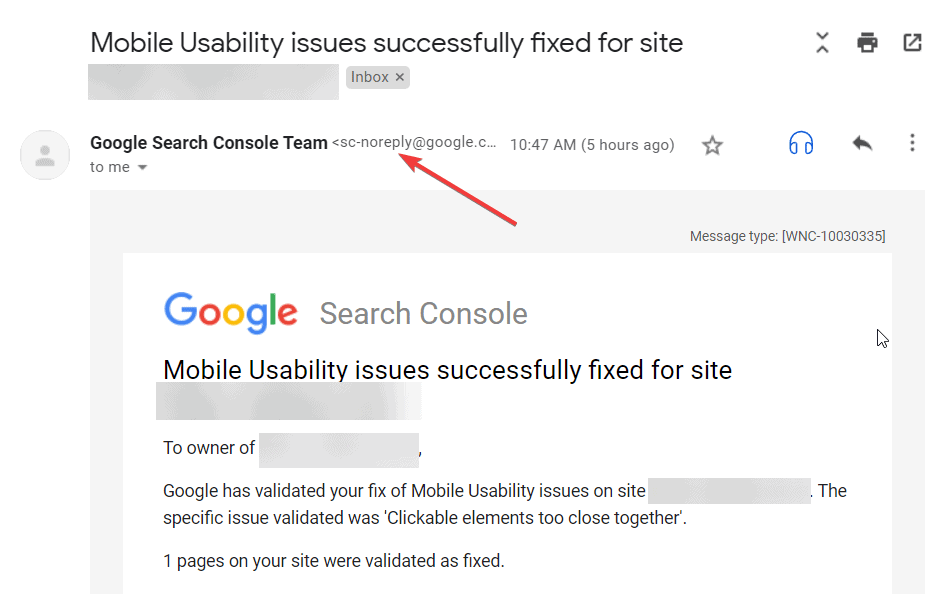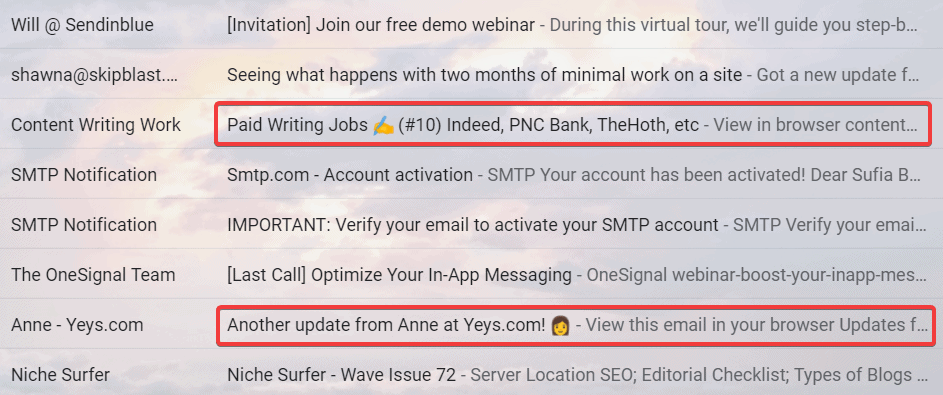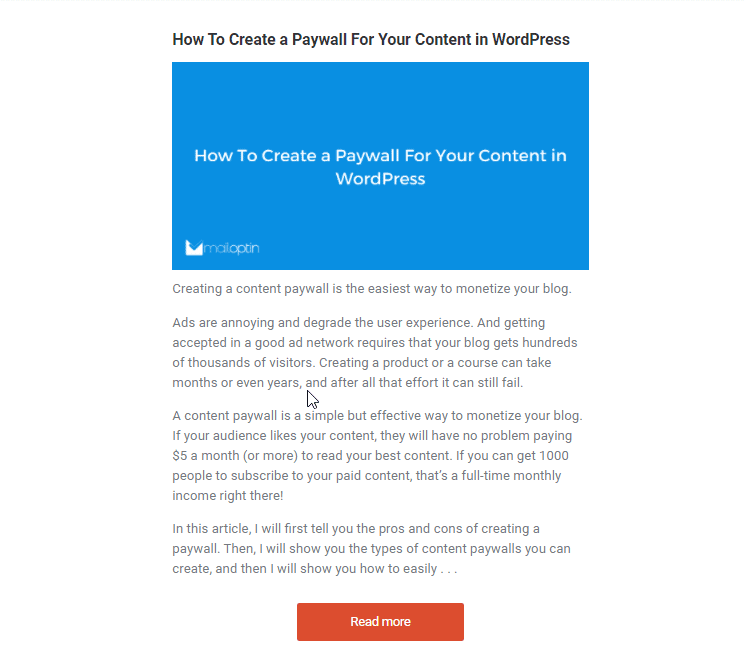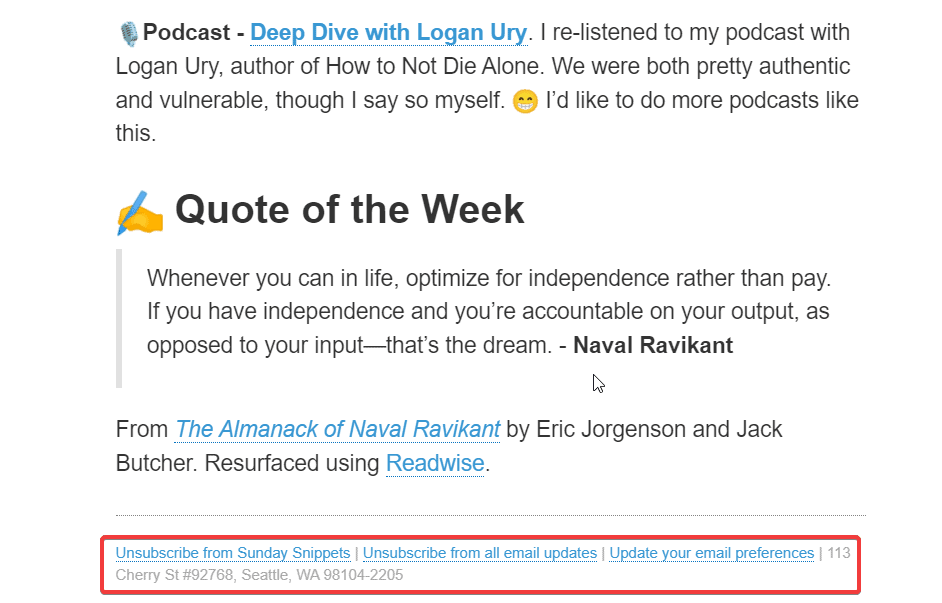21 Email Marketing Best Practices to Generate More Sales
Looking for email marketing best practices?
Email marketing is one of the oldest and most effective marketing channels for online businesses. It is a low-cost method of engaging with your customers and generating more sales.
Running successful email marketing campaigns requires time, dedication, and knowledge about email marketing practices that work. In this article, we will share with you email marketing practices that have been tried and tested time and again.
By following this guide, you should be able to run successful email marketing campaigns with significant engagement and conversions rates. Let’s get started.
21 Email Marketing Best Practices
There are 21 steps that you can implement to run a successful email campaign. We are taking a detailed look at each of these steps. Here we go:
1. Don’t Buy Subscribers
One of the first things to focus on is to avoid buying subscribers.
When you run an email campaign, you want subscribers to open your emails and click on your CTAs. If you are contacting people whose information you bought and didn’t earn through interaction, your email campaigns are going to fail spectacularly.
Uninterested subscribers won’t open your emails, some who accidentally open them would exit or unsubscribe immediately. Many subscribers would go far as to mark your emails as spam which will be a disaster for your future campaigns.
Also, the General Data Protection Act (GDPR) requires you to seek permission from European recipients before using their data. When you buy subscribers, you don’t take any consent from subscribers on whether they want to be sent emails.
The bottom line is, don’t buy your subscribers, earn them.
2. Focus on Personalization
Trust is the foundation of long-term business success. In email marketing trust can be built by personalizing your emails. Personalizing techniques include adding your signature and a brand logo so that the email looks legitimate, starting emails using your subscriber’s first names and small greetings, writing text in a friendly but formal manner, etc.
Beyond all these, you can also segment your mailer list into common groups like gender, age, location, preferences, etc and address each group separately. Read more: How to personalize email marketing campaigns.
3. Avoid “noreply” Sender Address
Email marketing offers an opportunity to build a solid relationship with your subscribers. A noreply email address (like [email protected]) does not encourage interaction between the sender and the receiver.
Moreover, according to CAN-SPAM, recipients have the right to opt-out of email campaigns. By using a noreply email address you are discouraging subscribers who want to ask you to be removed from all your mailing lists.
Besides, sending an email using a noreply email address affects the trustworthiness of a business.

We highly recommend that you steer clear of the noreply sender address on your regular emails. Using noreply address (like [email protected]) makes sense only if you are sending emails like buying or shipping confirmations, changing primary email addresses, or resetting passwords.
4. Build an Email Template
Writing an email from scratch is a time-consuming task which is why marketers prefer to build a template that they can use whenever they want to launch a new campaign.
Most email marketing tools offer email templates that you can customize as per your needs. But you can also hire a developer to create an email template from scratch. Whatever you do, here’s are a few tips that you should consider: The design of the email should reflect your brand. The color of your logo and buttons, your fonts images should be similar to your website.
If you are creating an email from scratch, then your email template should not be wider than 650 pixels, or else it won’t show up correctly.
It’s important to make your email look professional and uncluttered. Use font sizes between 10-12 points and avoid using more than 3 typefaces.
Add the logo on the top, and avoid using too many images to prevent clutter. The footer should have a clear unsubscription link along with company information like location, social media handles, etc. And remember to keep your content brief and to the point.
5. Write Compelling Subject Lines
The subject line is one of the most important parts of your email. A persuasive subject line makes a world of difference in your open rates.
So what makes a persuasive subject line? It should be short, attention-grabbing, free of spam words, personalized, and urgent.
For instance, take this subject line: “We’re starting in 5 HOURS.” It has a 59% open rate. It’s short, it has urgency and it’s attention-grabbing.
Creating a subject line is time-consuming. Try using some of the following templates:
- The Best Of [Topic]
- Example: The Best of Ways to Generate Leads
- My Big [Topic] Mistake
- How We [Result] In [Timeframe]
- How To [Achieve Desired Result]
- [Authority’s Name] [Topic + Secret/Tips]
- Here’s Why We [Something Remarkable]
- How [Type Of Person] did [Action They Took]
- How Your [Data Point] Compares to Competitor’s
6. Optimize the Preview Text
When people receive an email, they notice 3 things right away: the sender, the subject line, and the preview text.
The preview text appears right below your subject line. It’s like a subtitle to the subject line. Needless to say, it has a significant impact on your open rates.
Many marketers don’t write the preview text so email clients like Gmail, Yahoo Mail, etc, use the first sentence of the email to create the preview text.
To edit the preview text, use the editor of your email marketing tool and optimize the text. Some marketers write a compelling opening sentence and leave it on the email client to use it as the preview text. But this method is very ineffective.
Consider this: You’ve sent a newsletter to your subscribers and at the top of your newsletter, the recipient’s email client adds this message: “Email not displaying correctly? Click here.” If you leave it on the email client to select the preview text, it’ll show that message and not the first sentence of your email.
Example of emails without proper preview text:

When you craft the preview text, don’t restate the subject line. Instead, add a complimentary sentence. Here’s how:
Subject line: 20% OFF On All Products
Preview text: Offer ending in the 2 days. Hurry!
7. Send a Welcome Email
For some marketers, welcome emails are an afterthought. It shouldn’t be. Welcome emails are meant to help onboard subscribers but it also an opportunity to make a solid first impression on your new subscribers and to set expectations.
In your welcome emails be sure to include a warm greeting, and tell recipients what to do next. You could ask them to complete setting up their account, read your best articles, follow your business on social media, or add you to their “safe senders” or contact list.
You will also need to inform subscribers how frequently they will receive your emails.
8. Test Emails Before Sending
Another email marketing best practice is to test your emails before sending them. Emails look different on different browsers and email clients. You will need to test your emails before sending them out to check if the designs and CTA buttons are working properly.
We recommend using tools like MailNinja Email Previewer, SubjectLine.com, etc to check how your emails are rendering in different browsers.
Also, consider adding a “view in browser” link at the top of your email. If subscribers can’t view your email on their email client-server, they can simply open the link and view the email on their browser.
9. Keep Emails Brief & Skimmable
We live in an increasingly distracted world where the ability to pay attention is shrinking. Subscribers don’t read entire emails therefore writing brief, skimmable emails are the only way to get recipients to read your emails.
Here are some tips on crafting brief and skimmable emails:
- Keep the message clear and concise
- Convey a single idea in a single paragraph
- Use bullet points and lists as much as possible
- Bold important information to draw people’s attention
- Use CTA buttons to inspire action
- Add relevant images to break up the monotony of reading text
- Use white spaces to leave some breathing room
- Stick to the ideal email length which is between 50 to 125 words
10. Inspire Action
The purpose of email marketing is to inspire some sort of action like clicking through to read an article or to try out a new feature or to buy products, among other things.
Data shows that adding videos in emails increases open rates by 24.68% and click-through rates by 3.31%. Likewise, image-based emails perform better, both in terms of the average open and click-through rates.
To persuade people to click through your emails, write interesting stories, add links to thought-provoking articles, add funny gifs and videos. Make the action you want the reader to take obvious with a clear CTA text and a colored button that stands out.
Example of an email with a striking CTA:

You can also create a sense of urgency to inspire action. For instance, you can add countdown timers on an offer to increase open rates and click-through rates.
11. Nail Day, Timing, & Frequency
Open rates and click-through rates change based on the day and time of sending emails.
If you have the time to run a series of experiments then you can find what day and time works for you. But if that’s not possible, then try sending emails on a weekly and monthly basis. GetResponse found the highest average open and click-through rates on weekly emails while MailerLite found the highest open rate on monthly emails. So we recommend testing out which email frequency works best for you.
As for which day you should send emails, Campaign Monitor found that Tuesdays and Wednesdays have the best open rates.
Most people check their emails at the beginning of the day so the best time to send an email is in the early morning. If you have subscribers from different countries then segment them based on location and then schedule your emails based on their time zones.
12. Optimize For Mobile
You need to optimize your emails for both desktop and mobile because many of your subscribers are likely to check your emails on their smartphones.
Most email marketing tools offer desktop, mobile, and tablet responsive email templates but we still recommend testing your emails on all 3 devices before sending them to subscribers, if you can. Also consider, using programs like Emails on Acid to preview and ensure that your emails look the way you intended.
13. Make Unsubscribing Easy
No matter how exciting and engaging your emails are some subscribers would want to unsubscribe for reasons like they have changed their careers and they don’t need your newsletters anymore. An unsubscription link enables them to quickly opt-out of emails they no longer need.
You might think that subscribers can simply ignore your email if they don’t need it but this will have an impact on your open rates. Moreover, some subscribers are likely to mark your emails as spam if you don’t enable them to unsubscribe. Email clients will mark your campaigns as spammy which will significantly reduce email deliverability. So although this may seem like an unorthodox email marketing best practice, you need to ensure that recipients can easily unsubscribe from your email.
Most email clients provide an unsubscription link right beside your email address but you should still add an unsubscription link somewhere down your emails.

Here are a few things to consider when adding an unsubscription link to your emails: Avoid asking people to fill in a survey form. It is fine to ask why they are leaving but this should be optional. Also, don’t force your subscribers to log into your app or website to unsubscribe. Don’t reduce the font size or lighten the font color of your subscription link. Make sure the button is visible and you’ve made no efforts to hide it.
14. Reward Active Subscribers
Pay special attention to subscribers who open your emails and click on your links on a regular basis. Reward them for their loyalty and engagement by offering special discounts or early access to new products. Incentivizing will ensure that they remain happy subscribers and continue to choose your services or store to make their purchases, instead of your competitors.
15. Plan For Holidays
Another email marketing best practice is to make plans for holidays.
Holidays like Christmas, Easter, Thanksgiving, etc offer marketing opportunities to businesses. You should make the most of it. Create special holiday offers and plan your campaigns ahead of time.
It’s worth noting that holiday seasons are unusually busy and some of your subscribers may want to opt-out of holiday sales. Some email marketing experts advise asking subscribers if they prefer not receiving emails during the holiday season. You could try it as an exercise in building trust with your subscribers.
16. Optimize Landing Page
If you are sending subscribers to a landing page, make sure that the transition is seamless. The colors, headlines, content, etc should be consistent with your email. Consistency goes a long way in building trust so when optimizing your landing page, consider the user experience of your subscribers.
17. Track Meaningful Metrics
Open rates, click rates, bounce rates, and the number of unsubscriptions are the most important metrics of any email campaign. But you don’t need to monitor them all. To determine which metrics to monitor, consider the purpose of the email.
Let’s say you have launched a new product feature and you want subscribers to try it out. Your main metric to watch in your email campaign is the click-through rates. But if you sent an email informing recipients about a change in the terms of services, open rates are the right metric to follow.
18. Clean Email List Regularly
Once you sign up with an email marketing tool and start your email campaigns, the tool will show you that a number of subscribers are bouncing off your emails.
A hard bounce indicates that the recipient’s email server is permanently unreachable. It typically happens when there are strict email security filters in place or if the email address no longer exists. A soft bounce occurs when there’s a temporary issue in the recipient’s server.
If a number of subscribers are bouncing off your emails then email clients like Gmail, Yahoo Mail and Outlook will mark your campaigns as spam. This is why you need to clean your email lists. Remove email addresses that are bouncing off your emails for months on end.
Another group of subscribers that you need to delete is those who don’t open your email at all.

19. Allow Subscription Option
Many of your active subscribers are likely to share your emails with others. Adding a subscription button makes it easy for other people to subscribe to your newsletters. Just make sure that the subscription button doesn’t distract or confuse your current subscribers.
Here’s an example of a subscription link on Mark Manson’s (self-help author) newsletter.

20. Design Emails For Accessibility
An email marketing best practice is to design emails for accessibility. According to WHO, over 2.2 billion people live with some form of visual impairment. Chances are some of your subscribers also have visual limitations.
To ensure that your marketing emails are read by everyone, we recommend taking the following steps:
- Use descriptive anchor text
- Add descriptive alt text to your images
- Use a contrast checker and black and grey fonts
These will ensure that people with visual challenges can clearly read or listen to your emails. To learn more about how you can make your emails accessible, check out the a11yproject.
21. Run A/B Testing
Email A/B testing, also known as email split testing, is an experiment that’ll help you figure out what your audience likes so that you can optimize your email campaigns accordingly.
While running an A/B test, you will be sending 2 different versions of your email to 2 different groups of your email list. The version with the most opens and clicks is the winning version. It tells you what your subscribers are responding to.
With that folks, we have come to the end of this list on email marketing best practices.
Conclusion
There are a ton of things one needs to do to run a successful email campaign. You probably can’t implement every tip that we have covered in this article but that should stop you from starting.
Do not expect huge open rates and click-through rates on your initial campaigns. The first few campaigns offer lessons that you need to incorporate in your future campaigns. With time, you will witness higher open and click-through rates.
It’s worth mentioning that testing is the best way to make your own email marketing best practices. We encourage you to run A/B tests and figure out what works for you.
We hope you found our guide insightful and if you want to read more about email marketing, then take a look at our blog.
